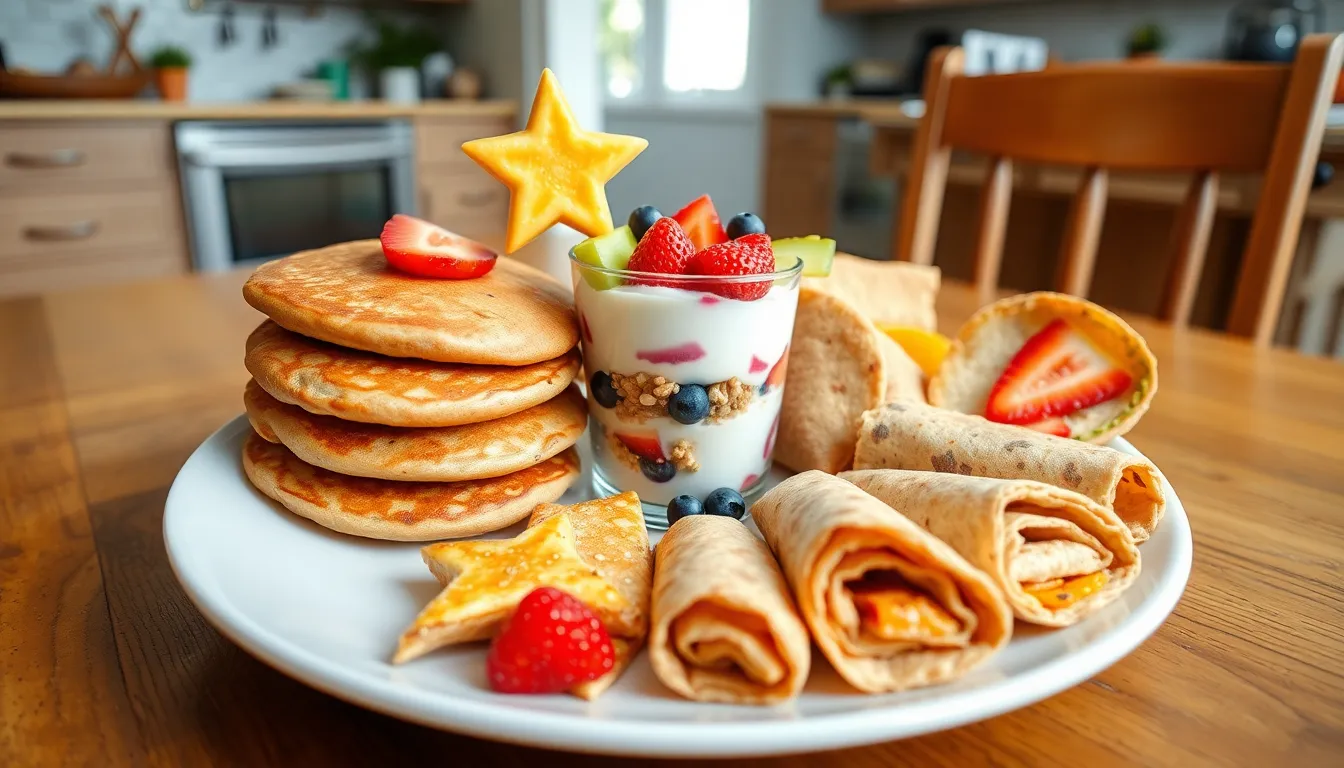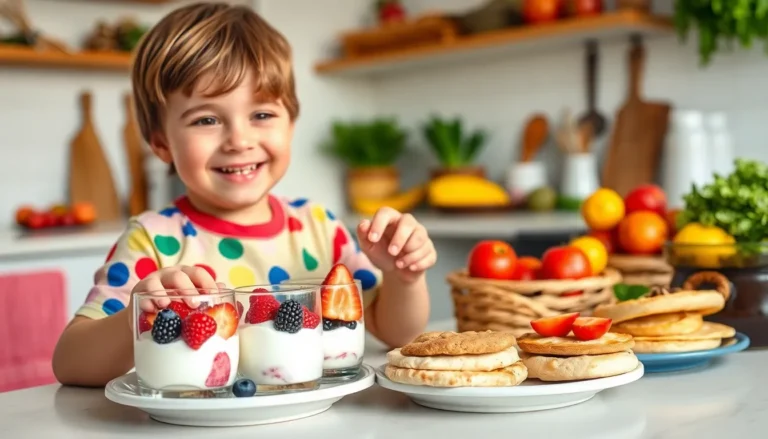Table of Contents
ToggleEvery parent knows the struggle of turning mealtime into a battlefield. One moment, a plate of veggies looks like a culinary masterpiece; the next, it’s a horror show that sends kids running for the hills. But what if meals could be both nutritious and fun? Enter the world of child-friendly meals, where creativity meets nutrition in a delicious dance that even the pickiest eaters can’t resist.
Imagine dishes that spark joy instead of tears, where broccoli becomes a tree and chicken nuggets transform into dino bites. With a sprinkle of imagination and a dash of humor, parents can whip up meals that not only satisfy hungry bellies but also ignite excitement at the dinner table. Let’s dive into the art of crafting meals that’ll have kids asking for seconds—because who said healthy can’t be hilarious?
Understanding Child-Friendly Meals
Creating meals that appeal to children involves combining fun and nutrition. Child-friendly meals entice kids through vibrant colors, creative shapes, and engaging presentations.
What Makes Meals Child-Friendly?
Child-friendly meals focus on appealing flavors and textures. Bright colors attract children’s attention, while bite-sized portions encourage self-feeding. Fun shapes, like stars or animals, make the food visually exciting. Also, incorporating familiar ingredients ensures acceptance. Finally, interactive elements, like build-your-own tacos or sandwiches, engage children during mealtime.
Nutritional Considerations
Nutritional balance remains essential in creating child-friendly meals. Each meal should include a variety of food groups, such as fruits, vegetables, whole grains, and proteins. Iron-rich foods, like lean meats and legumes, support healthy growth. Healthy fats from sources like avocados and nuts promote brain development. Moderating sugar and salt content fosters positive eating habits. Finally, introducing diverse flavors early encourages an adventurous palate.
Popular Types of Child-Friendly Meals

Child-friendly meals come in various forms that aim to please both parents and their children. These meals often prioritize nutrition while remaining appealing and fun.
Breakfast Ideas
Breakfast options can be exciting and healthy. Oatmeal topped with fresh berries provides fiber and antioxidants. Yogurt parfaits featuring granola and sliced bananas offer calcium and energy. Fun shapes made from whole grain pancakes, like stars or animals, invite creativity. Smoothies packed with spinach, banana, and yogurt deliver essential vitamins while being easy to drink. Eggs, scrambled with colorful vegetables, deliver protein and nutrients children need for the day.
Lunch Options
Lunch choices can mix nutrition with fun. Mini whole grain wraps filled with turkey, cheese, and lettuce allow for easy handling. Veggie sticks, accompanied by hummus, encourage healthy snacking. Cheese quesadillas cut into triangles serve as a protein-rich option. Fruit skewers made with melon, grapes, and strawberries captivate with their colors. Additionally, homemade pizza on whole wheat crust lets kids customize their toppings for an enjoyable meal.
Dinner Choices
Dinner selections can balance flavor and nutrients. Baked chicken tenders with a crispy coating provide a healthier alternative to fried options. Stir-fried vegetables with brown rice offer a medley of colors and tastes. Pasta tossed with homemade tomato sauce and hidden veggies allows parents to sneak in nutrition. Fish tacos topped with diced avocado and cabbage hit both taste and texture notes. Lastly, hearty lentil soups provide protein and warmth during colder months.
Tips for Preparing Child-Friendly Meals
Preparing meals that kids will enjoy can turn mealtime into a positive experience. Using a few strategies can enhance the process, making it easier to encourage healthy eating.
Involving Children in Meal Prep
Involving kids in meal preparation fosters excitement about food. They can wash vegetables, mix ingredients, or even choose toppings. Engaging them in age-appropriate tasks builds their confidence and interest in cooking. For example, toddlers can help by tearing lettuce or stirring batter, while older children might handle chopping ingredients with supervision. When kids participate in preparing meals, they’re more likely to eat what they’ve made. Cooking also provides an opportunity to teach nutrition and healthy eating choices.
Creative Presentation Techniques
Creative presentation can make meals visually appealing to children. Arranging food into fun shapes, like stars or animals, captures their attention. For instance, using cookie cutters on sandwiches or fruits not only piques their interest but also transforms ordinary meals into works of art. Bright colors enhance the visual appeal, making dishes more enticing. Combining different textures adds another dimension; pairing crunchy veggies with creamy dips encourages exploration. Building themed plates, like a rainbow platter with varied fruits and veggies, can further excite young diners about healthy eating.
Benefits of Child-Friendly Meals
Child-friendly meals promote nutritional intake while making mealtime enjoyable. Parents often notice several advantages when they incorporate these meals into their children’s diets.
Encouraging Healthy Eating Habits
Child-friendly meals encourage healthy eating habits from a young age. Incorporating a variety of fruits, vegetables, and whole grains provides essential nutrients. Introducing diverse flavors and textures early helps children develop a broad palate. Engaging children in meal preparation sparks their interest in food choices and nutrition. When kids participate, they’re more likely to try new foods and appreciate balanced meals.
Reducing Mealtime Struggles
Child-friendly meals significantly reduce mealtime struggles. It’s common for children to show resistance toward unfamiliar foods. Implementing creative presentations and interactive elements, like build-your-own options, boosts engagement. Focusing on vibrant colors and fun shapes captures children’s attention, making eating more enjoyable. Offering smaller, bite-sized portions allows kids to self-feed and explore their options independently. These strategies shift the focus away from conflict and toward positive experiences at the dining table.
Creating child-friendly meals is an essential strategy for parents aiming to nourish their kids while making mealtime enjoyable. By incorporating vibrant colors fun shapes and interactive elements parents can transform ordinary meals into exciting culinary adventures. Engaging children in the cooking process not only fosters a sense of ownership but also encourages them to explore new flavors and textures.
With a focus on nutrition and creativity parents can cultivate positive eating habits that last a lifetime. The journey to healthier eating doesn’t have to be a battle. Instead it can be a joyful experience that brings families together around the table.







